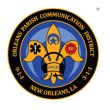FCC adopts new rules for Z-axis vertical location of wireless 911 callers, but critics question their practical use
FCC commissioners yesterday voted to approve rules requiring wireless carriers to deliver 911 callers’ vertical location that is accurate within three meters in most cases, but critics expressed concern that the location information will not be provided in a manner that is useful to public safety.
Under the new order, vertical—or Z-axis—80% of indoor wireless 911 calls would have to include vertical-location, or Z-axis, information that is accurate within plus or minus 3 meters, relative to the device’s location. Carriers must meet this requirement in the top 25 market by April 3, 2021, and in the top 50 markets by April 3, 2023, according to an FCC fact sheet on the subject.
The 3-meter metric has been an important point for public-safety representatives, because it represents the approximate height of the ceiling for most floors in multi-story buildings. Wireless carriers previously sought a 5-meter vertical-location metric for indoor 911 calls.
“When you dial 911 for help, every second counts—that is why first responders need to be able to find you as quickly as possible,” FCC Chairman Ajit Pai said during the open meeting, which was webcast. “But when you call 911 from a wireless phone in a multistory building—as many Americans do every day—this can be a challenge. First responders may know what building address you’re calling from, but they might find it difficult—if not impossible—to figure out which floor you’re on.
“Today, we aim to close this gap. We do this by adopting a vertical, or ‘Z-axis,’ location accuracy metric of plus or minus 3 meters for 80% of wireless E911 calls from Z-axis-capable handsets. In English, this means that first responders will now be able to more accurately identify the floor level for most 911 calls and reduce emergency-response time.”
While the 911 vertical-location order was adopted, the vote was not unanimous. FCC Commissioner Jessica Rosenworcel dissented in part, noting that the height-above-ellipsoid (HAE) format that the carriers must use to deliver vertical-location information is not useful to public safety.
“There is not one 911 call center today that can take the raw numbers in height above ellipsoid and translate them into actionable dispatchable-location information,” Rosenworcel said during a press conference following the FCC open meeting. “If we acted in this room today like the job is done, then we lied to you. And I’m afraid our decision was dishonest about whether the information is actionable.
“The fact so many 911 operators wrote into the agency and wrote to my office, telling me they were distressed that we would organize around information they could not use, I think is a testament to the fact that … we have a lot more work to do.”
In 2015, the FCC adopted 911 location-accuracy rules that established timelines for wireless carriers to provide either dispatchable-location information or coordinate-based location information. Many public-safety organizations have said that providing dispatchable location—a street address, plus the floor or room number—should be the goal, because that location format would be something that dispatchers can use.
Rosenworcel said there is a “significant fear” that the absence of a dispatchable-location requirement in the order approved yesterday means that dispatchable location may not be addressed by this FCC, although associated notice seeks comments on improvement to 911 location accuracy and alternatives to dispatchable location.
Delivering a dispatchable location can be difficult, according to industry sources. Extensive mapping would be needed to translate Z-axis coordinates into floor levels, as floor height and numbering systems can vary—for instance, many hotels and other buildings do not have a 13th floor.
FCC Commissioner Brandon Carr said during the meeting that he wants carriers to get to floor-level location accuracy and expressed support for aspects of the further notice that are designed to reach that point. But first responders also can encounter other circumstances that can make floor-level information moot, he noted in his prepared statement.
“The floor from which the 911 call came won’t matter, if the floor has collapsed,” according to Carr’s prepared statement. “The true height — or HAE [height above ellipsoid] — approach we adopt has promise and is technically feasible today. But I think we all agree that we shouldn’t put all of our chips on one particular technology.
“That’s why the further notice presses carriers, handset makers, and software companies to keep working on this data challenge, so we can raise the standard as technology evolves. At the same time, we certainly shouldn’t put all of our chips on another technology, the makers of which say is not ready for prime time. And that’s particularly true when we can foresee that the technology won’t work in so many emergency circumstances — for example, when the power is off.”
With all of these factors in mind, Pai described the order as a “meaningful step forward.”
Indeed, getting vertical-location information with 911 calls within 3-meter accuracy in the near term is more helpful than waiting for all aspects of the dispatchable-location challenge to be resolved, according to Harold Schaitberger, president of the International Association of Fire Fighters (IAFF).
“We cannot let the perfect be the enemy of the good,” Schaitberger said during the FCC meeting. “This proposal is good and will allow us to save many lives.”
This sentiment was echoed by many public-safety organizations, according to an FCC press release. Supporting public-safety organizations include the International Association of Fire Chiefs (IAFC), the International Association of Chiefs of Police (IACP), the National Association of State EMS Officials (NASEMO), the National Sheriffs’ Association, the National Association of State 911 Administrators, and NENA: The 9-1-1 Association, which described the FCC action as one that “will undoubtedly help emergency responders.”
“The Z-axis metric put in place by today’s vote – the same metric agreed upon by industry and public safety – is both technically feasible and necessary for 9-1-1,” according to a NENA statement. “Further, NENA is pleased that the order goes beyond indoor-location needs, as the framework adopted today has potential applications for callers in multi-story urban buildings and wilderness environments alike.
“These rules lay a rock-solid foundation for innovations in location accuracy, mapping, and addressing. Just as important, the questions posed by the FNPRM are thoughtful and important; they raise critical-path issues that public safety, industry, and government will tackle collaboratively during the coming months. This extensive collaboration will be absolutely necessary to develop a comprehensive, interoperable, future-proof system for accurate, actionable, seamless three-dimensional location accuracy for 9-1-1.”
In stark contrast, the Association of Public-Safety Communications Officials (APCO) said the new 911 location regulations “fail the citizens of the United States,” echoing Rosenworcel’s concerns that HAE location information will not be useful to public safety. APCO had advocated that any Z-axis rules require wireless carriers to provide at least floor-level location information.
“The Commission delivered a major win for wireless carriers and the one or two companies that can be used to fulfill these new regulatory requirements,” APCO Executive Director and CEO Derek Poarch said in a prepared statement. “The carriers are already indicating that they will underperform on these weak requirements and abandon efforts that had been underway to make more significant improvements.
“The Commission had the responsibility to do the right thing for our citizens’ safety. Instead, the Commission is giving the carriers a pass, failing the American public, and leaving many issues unresolved that will ultimately cause its plan to fail. Lives will be lost as a result.”

















